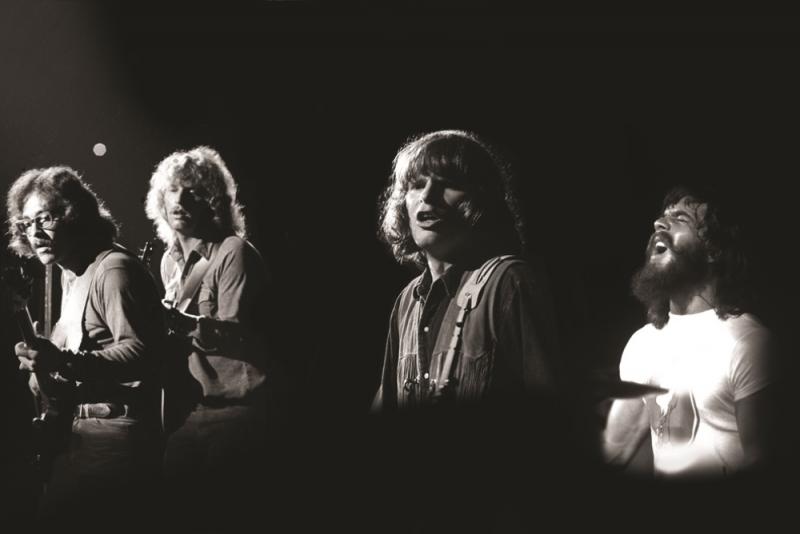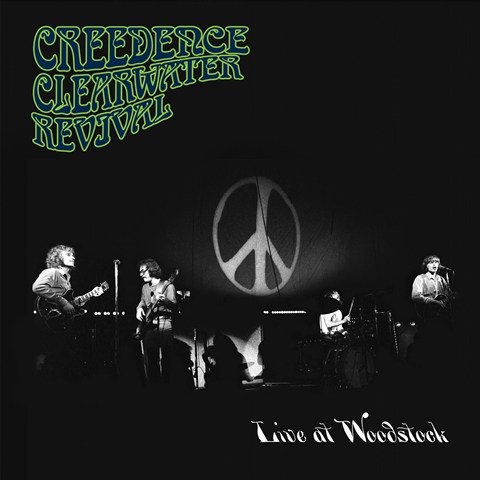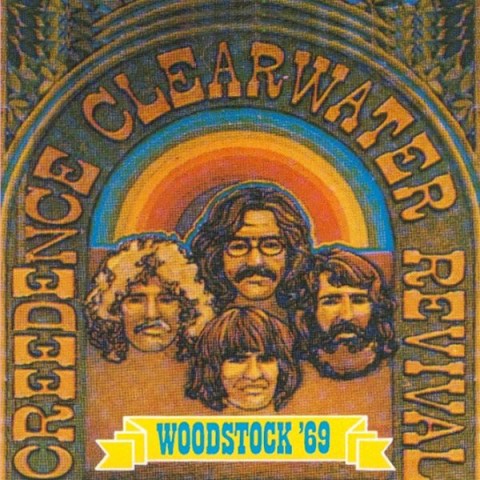Reissue CDs Weekly: Creedence Clearwater Revival - Live at Woodstock | reviews, news & interviews
Reissue CDs Weekly: Creedence Clearwater Revival - Live at Woodstock
Reissue CDs Weekly: Creedence Clearwater Revival - Live at Woodstock
Overdrive and relentlessness define the great American band’s 1969 festival appearance

Apparently, Creedence Clearwater Revival drummer Doug Clifford’s snare drum broke during the first song of their set at Woodstock Festival. On the new double album Live at Woodstock, it’s impossible to detect this happening. As “Born on the Bayou” progresses, the band’s forward motion is relentless and their dedication to the groove is undiminished during this and the remainder of a blistering, paint-peeling set.
The absences didn’t matter. CCR’s profile was unaffected. Green River, their totemic third album, was issued a week-and-a-half before Woodstock. It was the second of three LPs they released in 1969. Their 1969 singles – which included the As and Bs “Bad Moon Rising”, “Born on the Bayou”, “Down on the Corner”, “Fortunate Son”, “Green River” and “Proud Mary”– were all smashes. They were and are a great American band, fusing directness with an explicit identity.
 CCR were the first band contracted to play Woodstock. Their fee was $10,000. Joan Baez was paid the same. Only Blood, Sweat and Tears ($15,000) and Jimi Hendrix ($18,000) got more. CCR ended up playing between sets by Grateful Dead ($2,500) and Janis Joplin ($7,500). The Who's fee was $6,250.
CCR were the first band contracted to play Woodstock. Their fee was $10,000. Joan Baez was paid the same. Only Blood, Sweat and Tears ($15,000) and Jimi Hendrix ($18,000) got more. CCR ended up playing between sets by Grateful Dead ($2,500) and Janis Joplin ($7,500). The Who's fee was $6,250.
In bald terms, the numbers confirm CCR’s position in the pop pecking order of 1969. At Woodstock, they were sandwiched between The Grateful Dead and Janis Joplin, and went on at 12:30am on Sunday 17 August. They’d most recently played with the Dead on 28 May at San Francisco’s Winterland but had not previously been billed with Joplin and her band.
Although not strictly a San Francisco band, CCR ascended through the city’s ballroom circuit so knew exactly what the other Bay Area bands were about and what they were going to contrast with. Theirs was a keen appreciation of who else was out there. On 2 August they’d played Atlantic City, New Jersey with Tim Buckley, the Butterfield Blues Band, The Byrds, the Crazy World of Arthur Brown and Jefferson Airplane. The last date they played before Woodstock was a headliner at New York’s massive Singer Bowl Stadium.
 The CCR Woodstock set is – supposed drum shenanigans aside – as confident as would be expected and thanks to Fogerty’s excision of the band from the festival’s narrative stands apart from the deadening hoo-hah and hype surrounding the event as it hasn’t officially been heard until now. It had circulated on tape and first hit CD as a bootleg in 1989 (pictured left). Three tracks were extracted from the set for the legal 2009 box set Woodstock 40 Years on: Back to Yasgur's Farm. Now, 50 years after Woodstock, the whole thing has been issued.
The CCR Woodstock set is – supposed drum shenanigans aside – as confident as would be expected and thanks to Fogerty’s excision of the band from the festival’s narrative stands apart from the deadening hoo-hah and hype surrounding the event as it hasn’t officially been heard until now. It had circulated on tape and first hit CD as a bootleg in 1989 (pictured left). Three tracks were extracted from the set for the legal 2009 box set Woodstock 40 Years on: Back to Yasgur's Farm. Now, 50 years after Woodstock, the whole thing has been issued.
Sound quality-wise, what’s released isn’t that far from the bootleg. There’s a greater clarity, separation and toppiness but no surprises. What hits (very) hard though is the band’s focus and power. There is no flam-flam. The steamhammer version of “I Put a Spell on You” kicks into an overdrive at 02.47 setting them alongside the Detroit bands of the period. Live at Woodstock shuts down the 1970 Oakland show erroneously issued in 1980 as The Royal Albert Hall Concert.
Whether this urgency was typical of the 1969 CCR or a reaction to coming on after The Grateful Dead (judging by what’s been issued, it was a flaccid performance) is impossible to tell. But it is certain that Fogerty and co were a full-bore proposition. While splendid to have this red-hot show available – the only let-up comes during some fiddling about with the drums after third song “Ninety-Nine And a Half (Won’t do)” – the packaging is perfunctory. There are no liner notes and, surely, there are more photographs from the performance than the three which are used. As a landmark release, Live at Woodstock deserves bells and whistles rather than the thin presentation it's been given.
- Next week: Factory Records could-have-beens Tunnelvision
- Read more reissue reviews on theartsdesk
- Kieron Tyler’s website
Share this article
The future of Arts Journalism
You can stop theartsdesk.com closing!
We urgently need financing to survive. Our fundraising drive has thus far raised £49,000 but we need to reach £100,000 or we will be forced to close. Please contribute here: https://gofund.me/c3f6033d
And if you can forward this information to anyone who might assist, we’d be grateful.

Subscribe to theartsdesk.com
Thank you for continuing to read our work on theartsdesk.com. For unlimited access to every article in its entirety, including our archive of more than 15,000 pieces, we're asking for £5 per month or £40 per year. We feel it's a very good deal, and hope you do too.
To take a subscription now simply click here.
And if you're looking for that extra gift for a friend or family member, why not treat them to a theartsdesk.com gift subscription?
more New music
 Waylon Jenning’s 'Songbird' raises this country great from the grave
The first of a trove of posthumous recordings from the 1970s and early 1980s
Waylon Jenning’s 'Songbird' raises this country great from the grave
The first of a trove of posthumous recordings from the 1970s and early 1980s
 Lady Gaga, The Mayhem Ball, O2 review - epic, eye-boggling and full of spirit
One of the year's most anticipated tours lives up to the hype
Lady Gaga, The Mayhem Ball, O2 review - epic, eye-boggling and full of spirit
One of the year's most anticipated tours lives up to the hype
 Slovenian avant-folk outfit Širom’s 'In the Wind of Night, Hard-Fallen Incantations Whisper' opens the door to inner space
Unconventional folk-based music which sounds like nothing else
Slovenian avant-folk outfit Širom’s 'In the Wind of Night, Hard-Fallen Incantations Whisper' opens the door to inner space
Unconventional folk-based music which sounds like nothing else
 'The Art of Loving': Olivia Dean's vulnerable and intimate second album
Neo soul Londoner's new release outgrows her debut
'The Art of Loving': Olivia Dean's vulnerable and intimate second album
Neo soul Londoner's new release outgrows her debut
 Music Reissues Weekly: The Peanut Butter Conspiracy - The Most Up Till Now
Definitive box-set celebration of the Sixties California hippie-pop band
Music Reissues Weekly: The Peanut Butter Conspiracy - The Most Up Till Now
Definitive box-set celebration of the Sixties California hippie-pop band
 Doja Cat's 'Vie' starts well but soon tails off
While it contains a few goodies, much of the US star's latest album lacks oomph
Doja Cat's 'Vie' starts well but soon tails off
While it contains a few goodies, much of the US star's latest album lacks oomph
 Mariah Carey is still 'Here for It All' after an eight-year break
Schmaltz aplenty but also stunning musicianship from the enduring diva
Mariah Carey is still 'Here for It All' after an eight-year break
Schmaltz aplenty but also stunning musicianship from the enduring diva
 Album: Solar Eyes - Live Freaky! Die Freaky!
Psychedelic indie dance music with a twinkle in its eye
Album: Solar Eyes - Live Freaky! Die Freaky!
Psychedelic indie dance music with a twinkle in its eye
 Album: Night Tapes - portals//polarities
Estonian-voiced, London-based electro-popsters' debut album marks them as one to watch for
Album: Night Tapes - portals//polarities
Estonian-voiced, London-based electro-popsters' debut album marks them as one to watch for
 Album: Mulatu Astatke - Mulatu Plays Mulatu
An album full of life, coinciding with a 'farewell tour'
Album: Mulatu Astatke - Mulatu Plays Mulatu
An album full of life, coinciding with a 'farewell tour'
 Music Reissues Weekly: Sly and the Family Stone - The First Family: Live At Winchester Cathedral 1967
Must-have, first-ever release of the earliest document of the legendary soul outfit
Music Reissues Weekly: Sly and the Family Stone - The First Family: Live At Winchester Cathedral 1967
Must-have, first-ever release of the earliest document of the legendary soul outfit

Add comment